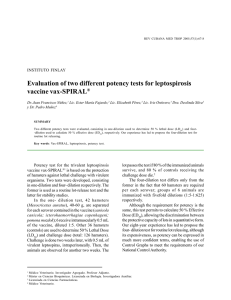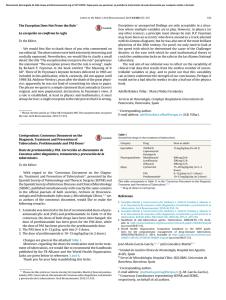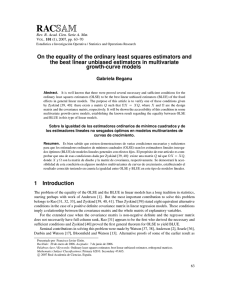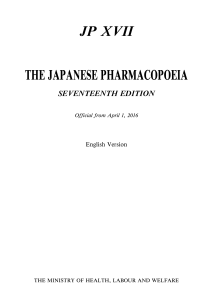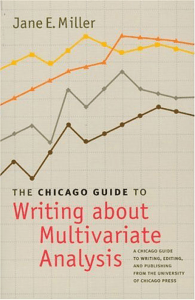the relative potency of two preparations applied in the
Anuncio
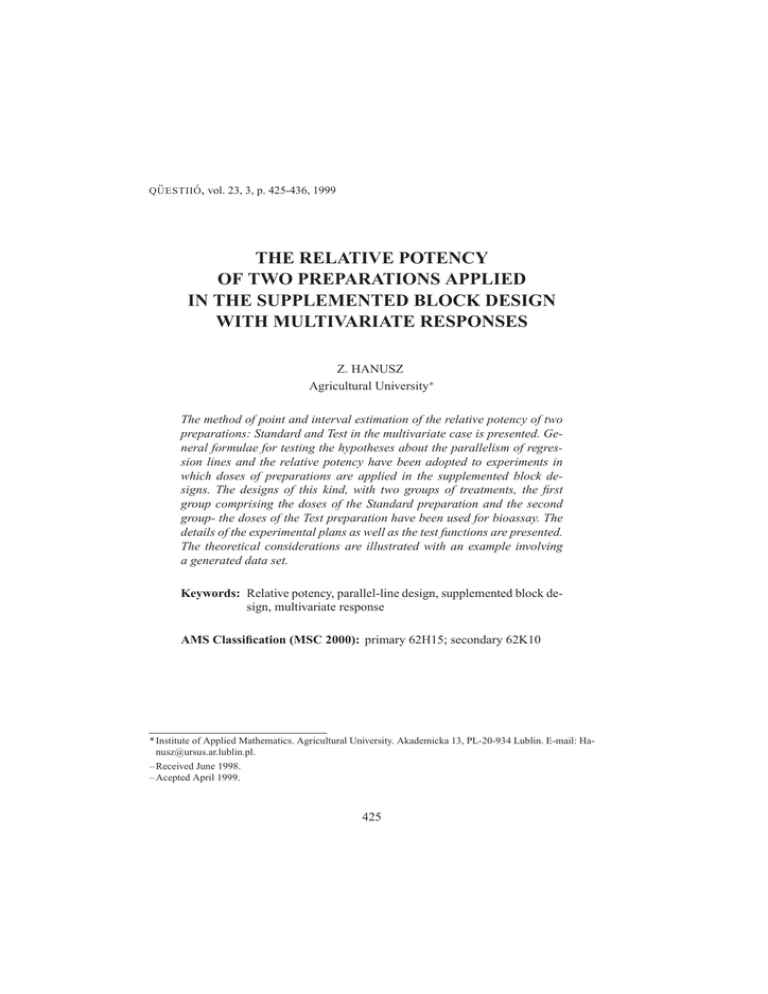
Q ÜESTII Ó , vol. 23, 3, p. 425-436, 1999 THE RELATIVE POTENCY OF TWO PREPARATIONS APPLIED IN THE SUPPLEMENTED BLOCK DESIGN WITH MULTIVARIATE RESPONSES Z. HANUSZ Agricultural University∗ The method of point and interval estimation of the relative potency of two preparations: Standard and Test in the multivariate case is presented. General formulae for testing the hypotheses about the parallelism of regression lines and the relative potency have been adopted to experiments in which doses of preparations are applied in the supplemented block designs. The designs of this kind, with two groups of treatments, the first group comprising the doses of the Standard preparation and the second group- the doses of the Test preparation have been used for bioassay. The details of the experimental plans as well as the test functions are presented. The theoretical considerations are illustrated with an example involving a generated data set. Keywords: Relative potency, parallel-line design, supplemented block design, multivariate response AMS Classification (MSC 2000): primary 62H15; secondary 62K10 * Institute of Applied Mathematics. Agricultural University. Akademicka 13, PL-20-934 Lublin. E-mail: [email protected]. – Received June 1998. – Acepted April 1999. 425 1. INTRODUCTION One of the methods of comparing two preparations, where one preparation is known (Standard) and the other is new (Test), is estimation of their relative potency. In the case of parallel-line designs, the relative potency, ρ, is defined as the ratio of a dose of the Test preparation to such a dose of the Standard preparation that produces the same average response. The relative potency allows us to indicate which dose of the Test preparation produces the same response as one dose of the Standard preparation. This problem concerning univariate and multivariate observations was considered by many authors: Finney (1978), Meisner et al. (1986), Laska et al. (1985), Williams (1988), Vølund (1980, 1982), Carter and Hubert (1985), Rao (1954), Hanusz (1995) and many others. In the multivariate case, most of the authors considered the problem of point and interval estimation of the relative potency of preparations administered on homogenous experimental units. A similar problem arises when we apply doses of the preparations to units which are not homogenous. Especially, with agricultural experiments involving herbicides, for example, the most suitable designs for experiments are blocks. However, in the case where doses of two preparations are administered in blocks, then the supplemented block design should be recommended. In literature, supplemented block designs, also referred to as augmented or reinforced block designs were considered in papers: Nigam et al. (1988), Ceranka, Krzyszkowska, (1992, 1994), Caliński, Ceranka (1974). Blocks of the supplemented block designs contain basic and additional treatments. In particular, these designs can be adopted to bioassays if the doses of the Standard preparation constitute the basic treatments and the doses of the Testadditional treatments. In the paper we consider the multivariate setting where for each dose of the preparations a multivariate response is measured. On the responses we make basic assumptions: normality, the same covariance matrix for all responses, mutual uncorrelation between the responses, and the linear relation between the responses and the logarithm to base 10 of the doses. The formulae for testing hypotheses connected with parallelism and relative potency according to the experimental plan are presented. Finally, theoretical considerations are illustrated with an example involving a simulated data set. 2. NOTATIONS AND LINEAR MODEL To describe a model of responses to the doses of the preparations administered in the supplemented block design let us introduce some notations. Let us consider a design with b blocks which are divided into two subblocks where the doses of the Standard preparation are applied on the first subblock and the doses of the Test preparation on the second subblock of each block. Let kS , kT be the (b × 1) vectors of numbers of plots in the subblocks in each block. Suppose that the ith preparation is applied on νi doses denoted by uij (i = S, T ; j = 1, . . . , νi ). The doses of the preparations are 426 replicated in the experiment, so let ri be the (νi × 1) vector of dose replications of the ith preparation. For example, let us consider the experimental plan with the doses of the Standard and the Test preparations administered in four blocks in the following way: (2.1) B1 uS1 uS3 uS2 uT 2 uT 1 uT 3 B2 uS1 uS3 uT 1 uT 2 uT 3 B3 uS1 uS2 uS3 uT 1 uT 3 uT 2 B4 uS2 uS1 uT 3 uT 2 uT 1 The plan (2.1) is described by: b = 4, νS = νT = 3, kS = [3, 2, 3, 2]′ , kT = [3, 3, 3, 3]′ , rS = [4, 3, 3]′ , rT = [4, 4, 4]′ . The above vectors fulfill the following relations: r′S 1νS = k′S 1b = nS = 10, r′T 1νT = k′T 1b = nT = 12, where 1i denotes the vector of i ones and nS , nT are the total numbers of plots where the doses of S and T are applied. This experimental plan is also uniquely characterized by the incidence matrix N, defined as: 1 1 1 1 uS1 1 0 1 1 uS2 1 1 1 0 uS3 · ¸ NS 1 1 1 1 N= = uT 1 NT 1 1 1 1 uT 2 1 1 1 1 uT 3 B1 B2 B3 B4 The matrix N shows that in the plan (2.1) the doses of the preparations appeared once in each block, only the second and the third dose of the Standard did not appear in the second and the fourth block. Moreover, the submatrices NS and NT fulfil the equalities: NS 1b = rS , NT 1b = rT , N′S 1νS = kS , N′T 1νT = kT . Let us assume that for each dose of the preparations S and T a p-variate response vector is observed. Let us denote this response by yijkl , where i = S, T ; j = 1, . . . , νi ; k = 1, . . . , rij ; l = 1, . . . , b and rij is the jth component of the vector ri . In most assays, the responses are linearly related to the logarithm of the doses (Finney, 1978). Therefore, the response can be written as: (2.2) yijkl = αi + βi xij + τl + eijkl where τl denotes the (p × 1) vector of the effects of the lth block in which the dose uij was applied, αi , βi are the (p × 1) vectors of intercepts and regression slopes, 427 respectively, xij = log(uij ) denotes the logarithm to base 10 of the dose uij , eijkl is the vector of errors corresponding to yijkl . As the whole experiment involves the total number of experimental units n = nS + nT so the matrix (n × p) of all observations, ′ Y, whose rows are yijkl , can be written in the following form: Y = XB + E (2.3) τ′ and B = α′ is the ((b + 4) × p) matrix of parameters, where τ = [τ1 , τ2 , . . . , τb ] is β′ the (p × b) matrix of blocks effects, α = [αS , αT ] , β = [βS , βT ] are the (p × 2) matrices of intercepts and slopes, X = [D1 , D2 , ∆] is the (n × (b + 4)) matrix connected with the matrix of parameters B, where D1 is an (n × b) matrix connected with τ , having the entries equal · ¸ to 1 if the · considered dose ¸ appeared in the block or 0 otherwise, D2 = 1nS 0nS xS 0nS ,∆ = , and xi is the (ni × 1) vector of logarithms 0nT 1nT 0nT xT of all doses of the ith preparation applied in (2.1) and located in the same order as ′ responses yijkl in the matrix Y, E is an (n × p) matrix composed of all e′ijkl . About the model (2.3) we make assumptions that the rows of Y are independent and have the p-variate normal distribution with the same (p × p) unknown, positively defined covariance matrix, Σ. 3. TESTING HYPOTHESIS ABOUT THE SAME SLOPE Two preparations can be compared by the relative potency if they similarly influence the responses. This similarity exists when the vectors of slopes for the Standard and the Test preparations in model (2.3) are equal. It means that for each measured feature of the observations, the regression coefficients (slopes) are equal, so the regression lines of each feature of responses versus the doses of Standard and the Test preparations are parallel. Such models are called a parallel- line model. If the model (2.3) has this characteristic, then the following hypothesis should be true: (3.1) Hβ0 : L′ B = 0′ versus Hβ1 : L′ B 6= 0′ where L′ = [0′b , 0′2 , m′ ], m′ = [1, −1], and 0′i is the (1 × i) vector of nulls. To test the hypothesis Hβ0 in (3.1) we can use W ilks′ lambda or Lawley- Hotelling trace statistic and because rank(L′ ) = 1 then both statistics are equivalent (see Appendix B). Let 428 us take the W ilks′ lambda statistic which is defined as the ratio of two determinants: Λ= (3.2) where SH = e = B SE ³ e L′ B ´′ ³ − |SE | |SE + SH | ´−1 ³ ´ − e , L′ (X′ X) L L′ B (X′ X) X′ Y, ³ ´′ ³ ´ e e . = Y − XB Y − XB Using the transformation given in Meisner et al. (1986) we can write Λ in the following form: Λ= (3.3) 1 1+V ′ e) e )(SE )−1 (L′ B (L′ B . In the formula for V the general inverse to the matrix − e X X appears, so SH , B and SE depend on the general inverse (X′ X) . As this inverse we propose the matrix given in Appendix A1. Moreover, in the vector L′ , only the subvector m′ has not null elements, so V can be calculated using the formula: ´′ ´ ³ ³ e1 e 1 S−1 m′ B m′ B E (3.4) V = m′ H−1 m where V = L′ (X′ X)− L ′ e 1 = H−1 ∆′ ΦY, and formulae for H, ∆, Φ are given in A1 of the Appendix. where B Under the null hypothesis Hβ0 , n−b−p−2 · V has Snedecor′ s F distribution with (p, p n − b − p − 2) degrees of freedom. 4. ESTIMATION OF THE RELATIVE POTENCY Assuming the hypothesis (3.1) to be true, the model (2.3) can be reparametrized by replacing β consisting of two vectors βS and βT with one vector called also β. A new model takes a form: (4.1) Y =XB + E 429 τ′ where B = α′ , and τ , α remain the same as in (2.3) but β is the (p × 1) vector of β′ ˜ slopes and, consequently, · ¸ in the matrix X = [D1 , D2 , ∆], D1 , D2 remain the same but ˜ = ∆ · 12 = xS becomes a column vector. ∆ xT In parallel- line designs with the linear relation between the responses and the logarithm of the doses we get the logarithm of the relative potency, µ = log(ρ), which is the distance between the logarithms of doses of both preparations giving the same average responses. Let αSj , αT j , βj denote the jth components of the vectors αS , αT , β correspond to the jth feature. Then the dependence of µ on intercepts and slope can be illustrated on Figure 1. Figure 1. Logarithm of the relative potency in parallel-line design. α −α This figure shows that for the jth feature (j = 1, . . . , p), µ = Sjβj T j and if for each feature the same µ satisfies the above equality then in multivariate case the equality αS − αT − µβ = 0 should be true. In the matrix notation the equality takes a form: (4.2) Hµ0 : L′µ B =0′ versus Hµ1 : L′µ B 6=0′ where L′µ = [0′b , m′ , −µ]. To test (4.2) W ilks′ lambda statistic in the form (3.3) is used: 1 Λ(µ) = 1 + V (µ) with V (µ) defined in the same manner as V in (3.3), taking L′µ instead of L′ and X instead of X. Using the formula for the general inverse to the matrix X′ X given in 430 Appendix A2, we get the formula for V (µ) as the ratio of two quadratics on µ: (4.3) V (µ) = Aµ2 − 2B · µ + C aµ2 − 2b · µ + c ´ ³ ′ −1 e e βe = ∆ ˜ ′ βe , C = ˜ ′ ΦY, B = m′ α Y − ∆ where A = βe′ S−1 β, e S β, α e = F 2 E E m′ α e′ S−1 em, a = 1/h, b = m′ F2 , c = m′ (C− + hb2 b∗2 )m, and h, F2 , b2 , b∗2 , Φ E α and C are given in A1 and A2 of the Appendix. The problem of testing the hypothesis Hµ0 in (4.2) was discussed by Williams (1988), Carter and Hubert (1985), Meisner et al. (1986) or Hanusz (1995). The test derived by Carter and Hubert, improved by using Bartlett correction factor, compares n∗ · ln (1 + mı́n V (µ)) with the χ2 distribution with (p − 1) degrees of freedom, where 1 n∗ = n − r(X) − p−1 2 − máx V (µ) , ln is natural logarithm, min and max denote the minimum and maximum. If the hypothesis (4.2) is true then we take µ b as the estimator of the logarithm of the relative potency, for which the test function Λ(µ) achieves its maximum. The (1 − α) confidence interval for the logarithm of the relative potency is a set of µ satisfying the following inequality (see, Williams (1988), Meisner et al. (1986)): (4.4) © ¡ ¢ª P Λ(µ) > Λ(b µ) exp −χ2p−1 (α)/n∗ = 1 − α or: © ¡ ¢ ª P V (µ) ≤ (1 + V (b µ)) exp χ2p−1 (α)Án∗ − 1 = 1 − α where exp(·) denotes the exponential function. 5. NUMERICAL EXAMPLE To illustrate the theoretical consideration in Sections 2, 3 and 4 we consider a generated data set corresponding to the experimental plan (2.1). Let us take: the number of blocks, b = 4, the number of features in each observation, p = 3, the vectors of intercepts: ′ αS = [11, 21, 31]′ , αT = [10, 20,30]′ , the vectors of slopes: βS = βT = [1, 1, 1] , the 1 −2 5 −4 2 −3 2 , the same number of doses: matrix of block effects: τ = 0,01 −1 2 3 −1 −4 νS = νT = 3 and the same doses for the Standard and the Test preparations: 1, 10, 100 applied according to plan (2.1). Moreover, we assume that the covariance matrices 431 3 2 1 are the same for the Standard and the Test, and are equal to Σ = 2 2 1 . Using 1 1 4 the MapleV packet we generate the data set from the normal distribution, having a null expectation and unit variance. The data is allocated in a (22 × 3) matrix, and after some mathematical transformations, using Cholesky decomposition of Σ (see, Krzanowski, 1988, p.478) we obtain the matrix of the observation Y satisfying (2.3). To calculate the test function of the hypothesis about the same slopes in (3.1), the test function V is calculated using formula given in (3.4). We obtained : V = 0,227, Snedecor F statistic, under the truthfulness Hβ0 is equal to F 0 = 13 3 · V = 0,98 and the probability that F is smaller then F 0 is equal to 0.57, so the hypothesis in (3.1) is not rejected, therefore the model (2.3) describes a parallel- line design. When we consider the model (4.1) and the hypothesis Hµ0 in (4.2), we obtained: (5.1) V (µ) = 0,095µ2 − 0,060µ + 0,049 . 15 2 10 370 221 µ + 663 µ + 1989 Figure 2. Shape of W ilks′ lambda statistic for testing the hypothesis about the logarithm of Figure 2. the relative potency. and W ilks′ lambda statistic Λ(µ) = given on Figure 2: 1 1+V (µ) , for V (µ) described in (5.1) has a plot Calculating the extrema of Λ(µ) we obtain the minimum at point µ = −2,36 and the maximum at µ = 1,21. Moreover, χ20 = n∗ · ln (1 + mı́n V (µ)) = 2,43 and the probability that χ2 is smaller then χ20 is equal to 0.70, so the hypothesis in (4.2) is also not rejected. The point in which Λ(µ) achieves its maximum is taken as the estimator of 432 the logarithm of the relative potency, so µ b = 1,21. Using the inequality given in (4.4), the 95 per cent confidence interval for µ is given by the interval (0,99, 1,46). Putting to the equality: αS − αT − µβ = 0, the values of αS , αT and β, let us notice that the true value of µ is equal to 1. Having the point and interval estimators for the logarithm of the relative potency we obtain the suitable estimators for the relative potency, namely, ρb = 16,34 and ρ ∈ (9,92, 28,82). 6. CONCLUSION In the paper we present the method of estimation of the relative potency in parallelline assays. In literature, in the multivariate setting, the test functions using to test the multivariate hypotheses about parallelism and relative potency are presented in the case where the doses of preparations are administered to homogenous experimental units. In the experiments with homogenous experimental units, in the test functions given by (3.2) and (3.4) the inverse to X′ X and X′ X appeared and have unique forms. The problem of testing the same hypotheses in the case where the data is obtained on nonhomogenous experimental units is more complicated. The matrices X and X in (2.3) and (4.1) are not of full rank, so the general inverse matrices to X′ X, and X′ X have to be known to get the test functions. This problem is solved in the case where doses of both preparations are administered to units with one directional changeability of units formed the supplemented block designs. The formulae given in (3.4) and (4.3) gives us possibility to calculate the values of the test functions and as the result of estimating the relative potency, which was the objective of the paper. 7. REFERENCES Ahrens, H. and Läuter, L. (1974). Mehrdimensionale Varianzanalyse. Berlin, Akademie-Verlag. Caliński, T. and Ceranka, B. (1974). «Supplemented block designs». Biom. J., 16, 299305. Carter, E.M. and Hubert, J.J. (1985). «Analysis of Parallel-Line Assays with Multivariate Responses». Biometrics, 41, 703-710. Ceranka, B. and Krzyszkowska, J. (1992). «Block designs with two groups of treatments». Biometrical Letters, 29(2), 33-44. Ceranka, B. and Krzyszkowska, J. (1994). «Reinforced block designs with two groups of treatments». Biometrical Letters, 29(2). 17-25. Finney, D.J. (1978). Statistical method in Biological Assays, (3rd edition). London: Charles Griffin and Co., Ltd. 433 Hanusz, Z. (1995). «Relative Potency of Two Preparations in Two-way Elimination of heterogeneity Designs with Multivariate Responses». Biometrics, 51, 1133-1139. Krzanowski, W.J. (1988).Principles of Multivariate Analysis. Clarendon Press-Oxford. Laska, E.M., Kushner,H.B. and Meisner, M. (1985). «Multivariate bioassay». Biometrics, 41, 547-554. Meisner, M., Kushner, H. B. and Laska, E.M. (1986). «Combining multivariate bioassay». Biometrics, 42, 421-427. Nigam, A.K., Puri, P.D. and Gupta, V.K. (1988). Characterization and Analysis of Block Designs. John Wiley & Sons. Rao, C.R. (1954). «Estimation of the relative potency from multiple response data». Biometrics, 10, 208-220. Rao, C.R. and Mitra, S.K. (1971). Generalized Inverse of Matrices and Its Applications. John Wiley, New York. Vølund, Aa. (1980). «Combination of Multivariate Bioassay Results». Biometrics 38, 181-190. Vølund, Aa. (1982). «Multivariate Bioassay». Biometrics, 36, 225-236. Williams, D.A. (1988). «An exact confidence interval for the relative potency estimated from a multivariate bioassay». Biometrics, 44, 861-867. 434 APPENDIX A1. Formula for the general inverse of the matrix X′ X used in Section 2 The matrix X′ X of the model (2.3) has the following form: ′ δ D1 D1 D′1 D2 D′1 ∆ k K nδ X′ X = D′2 D1 D′2 D2 D′2 ∆ = K′ ∆′ D1 ∆′ D2 ∆′ ∆ ∆′ D1 ∆′ D2 where D′1 D1 D′1 D2 D′2 D2 D′1 ∆ D′2 ∆ ∆′ ∆ = kδ = diag(k) and k = kS + kT , = K =[kS , kT ], = nδ = diag(nS , nT ). Using the formula given in Rao and Mitra (1971, p.41), the general inverse to X′ X has the following form: −δ k (Ib + KC− K′ k−δ ) + b1 Hb∗1 , −k−δ KC− + b1 Hb∗2 , b1 − (X′ X) = C− + b2 Hb∗2 , b2 −C− K′ k−δ + b2 Hb∗1 , ∗ b∗2 , H−1 b1 , where H = ∆′ Φ∆, b1 = −F1 ∆H−1 , b2 = −F2 ∆H−1 , F2 = C− (D′2 − K′ k−δ D′1 ), F1 = k−δ (D′1 − KF2 ), C = nδ − K′ k−δ K Φ = In − D1 k−δ D′1 − F∗2 CF2 , b∗1 = −H−1 ∆′ F∗1 , b∗2 = −H−1 ∆′ F∗2 F∗2 = (D2 − D1 k−δ K)C− , F∗1 = (D1 − F∗2 K′ )k−δ , and C− denotes the general inverse to (2 × 2) matrix C. Let us notice that only in the case when the general inverse to C is symmetric then b∗1 , b∗2 , F∗1 , and F∗2 are the transposition of b1 , b2 , F1 and F2 , respectively. 435 A2. Formula for the general inverse of the matrix X′ X used in Section 4 The general inverse to the matrix X′ X from the model (4.1) has the following form: −δ k (Ib + KC− K′ k−δ ) + hb1 b∗1 , −k−δ KC− + hb1 b∗2 , b1 − (X′ X) = −C− K′ k−δ + hb2 b∗1 , C− + hb2 b∗2 , b2 ∗ b1 , b∗2 , h1 ˜ ′ Φ∆, ˜ is a constant now, and the others formulae remain the same as in where h = ∆ A1 taking the constant h instead of (2 × 2) matrix H. B. Equality of W ilks′ lambda and Lawley − Hotelling trace statistics When we test the hypothesis L′ B = 0′ , where the rank of the matrix L is equal to 1 then W ilks′ lambda statistic and Lawley − Hotelling trace statistic are equivalent. To show this, let us consider W ilks′ lambda statistic: Λ= (5.2) |SE | |SE + SH | ³ ´′ ³ ´−1 − e where |A| denotes the determinant of a matrix A, SH = L′ B L′ (X′ X) L ³ ´ ³ ´′ ³ ´ e ,B e = (X′ X)− X′ Y, SE = Y − XB e e . Meisner et al. (1986) L′ B Y − XB showed that Λ can be transform to the following form: Λ= 1 ³ ´′ . ´−1 ³ ´ − e e S−1 L′ B 1 + L′ (X′ X) L L′ B E ³ On the other hand, Lawley − Hotelling trace statistic is equal to: T 2 = trace(S−1 E SH ). Using the trace property we can write: µ ³ ´′ ³ ´−1 ³ ´¶ − ′e ′ ′ ′e T 2 = trace S−1 L B L (X X) L L B E µ³ ´ ³ ´′ ³ ´−1 ¶ − ′ ′ e S−1 L′ B e = trace L′ B L (X X) L E ³ ´−1 ³ ´ ³ ´′ − e S−1 L′ B e . = L′ (X′ X) L L′ B E Moreover in the case where rank(L) =1, and the hypothesis L′ B = 0′ is true then n−r(X)−p+1 1−Λ · Λ and n−r(X)−p+1 · T 2 have F Snedecor distribution with (p, n − p p r(X)−p + 1) degrees of freedom (see, Ahrens, Läuter, 1974). One can see that 1−Λ Λ = T 2. 436

